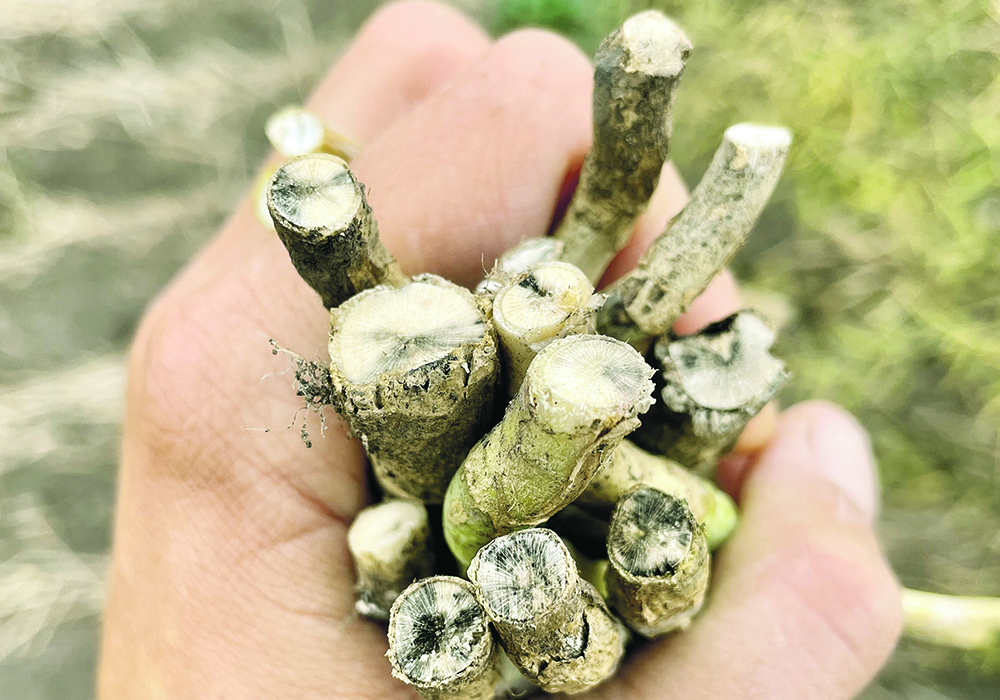Disease may have thrived in some fields because dryness prevented infected stubble from deteriorating as quickly as usual
Drought is normally an impediment to crop disease.
Disease spores and fungi prefer wet conditions, so the lack of rain this spring and early summer should have controlled most diseases in Western Canada.
That was true in many fields, but in some cases the drought didn’t hinder blackleg in canola.
“Some fields were loaded with it (and) others had no blackleg,” said Justine Cornelsen, an agronomist with the Canola Council of Canada in Manitoba.
Cornelsen, who is based in Virden, Man., was referring to canola fields she surveyed in Manitoba.
Read Also

Agritechnica Day 2: The future of tractor power, building quicker crop apps and large farms and tech
Agritechnica Day 2: The future of tractor power, building quicker crop apps with Syngenta and large farms and tech
Mike Harding, an Alberta Agriculture plant pathologist, saw a similar pattern in Alberta.
“The levels of blackleg were very low or absent in most fields, but then we had fields from various locations that had significant levels,” he said in an email. “In those fields, blackleg severity was higher than I remember seeing last year, or in previous years.”
Blackleg, also known as stem canker, is a common disease of canola. It restricts nutrient and moisture uptake in the plant and hinders yield.
Yield loss depends on the severity of the infection and the percentage of plants with blackleg.
Using the canola council’s yield loss calculator for blackleg, an infection severity of 3 (on a scale of 1 to 5) and a 40 percent blackleg incidence can cause a yield loss of six bushels per acre. At prices of $15 per bu., that’s around $90 per acre.
Cornelsen didn’t have estimates on the severity and prevalence of blackleg in Western Canada this summer. Those figures will be released Oct. 28-29, when the Western Committee on Crop Pests holds its annual meeting. The committee will summarize the insect and disease situation for this year, including a report on blackleg.
However, it seems like blackleg thrived on a number of canola fields in 2021, possibly because the fungus only requires a small amount of rainfall to explode.
“It needs moisture, but it doesn’t need a lot,” Cornelsen said. “I think the documented work is like two millimetres of rain. A really, really tiny amount. As long as that (canola) residue gets some (moisture) in the spring, it is ready to produce spores.”
The drought in Western Canada, which stretches back to 2017 in parts of the Prairies, may have actually been beneficial for blackleg. The fungus overwinters on canola stubble and can persist for years until the infected stubble decomposes.
Thanks to the dry springs and summers in recent years, canola stubble is sticking around longer than usual.
“In a dry cycle, you don’t have as much soil activity working to break that old residue down,” Cornelsen said. “You can easily find old canola residue in fields.”
Having canola residue isn’t a huge problem, unless it’s infected with blackleg.
On fields where Cornelsen found higher levels of the disease, the grower likely had a problem with blackleg a couple of years ago.
“Typically, it’s on these tight canola rotations.”
Lengthening the time between canola to three years is probably the best way to reduce the risk of blackleg in future crops.
On its website, the canola council recommends several measures:
- Using resistant varieties. Grow canola hybrids that have a moderately resistant or resistant rating to blackleg. Resistance reduces blackleg infection to specific races of blackleg, but does not mean the variety is immune to the disease
- Rotate varieties. Growing the same hybrid repeatedly on the same field will select for races of blackleg that can overcome genetic resistance in that hybrid
Growers should also think about yield robbers.
In a growing season like 2021, with 35 C days and weeks between rain, it’s easy to assume that heat and drought were the only reasons for a 15 bu. canola crop. But other agronomic issues, like blackleg, may have cut into yield.
“We’ve been trying to encourage people to look beyond that (heat and drought). What else was limiting (yield)?” Cornelsen said. “Some growers were still able to achieve really great yields. It wasn’t solely based on that they had (more) rain.”
















